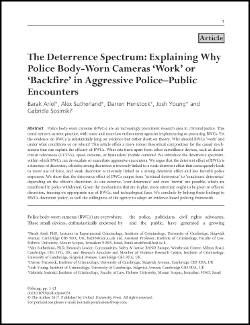
Police body-worn cameras (BWCs) are an increasingly prominent research area in criminal justice. This trend mirrors current practice, with more and more law enforcement agencies implementing or procuring BWCs. Yet the evidence on BWCs is substantially long on evidence but rather short on theory. Why should BWCs 'work' and under what conditions or on whom? This article offers a more robust theoretical composition for the causal mechanisms that can explain the efficacy of BWCs. What sets them apart from other surveillance devices, such as closed circuit televisions (CCTVs), speed cameras, or bystanders' mobile cameras? We introduce the deterrence spectrum, within which BWCs can de-escalate or exacerbate aggressive encounters. We argue that the deterrent effect of BWCs is a function of discretion, whereby strong discretion is inversely linked to a weak deterrent effect that consequently leads to more use of force, and weak discretion is inversely linked to a strong deterrent effect and less forceful police responses. We show that the deterrence effect of BWCs ranges from 'minimal deterrence' to 'maximum deterrence' depending on the officer's discretion. At one extreme, 'over-deterrence' and even 'inertia' are possible, which are manifested in police withdrawal. Given the mechanisms that are in play, more attention ought to be given to officers' discretion, training on appropriate use of BWCs, and technological fixes. We conclude by linking these findings to BWCs discretion policy, as well the willingness of the agency to adopt an evidence-based policing framework.
